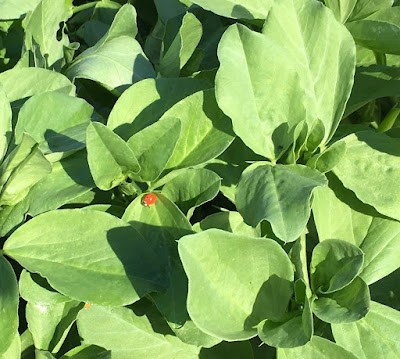
Bookmark these sites now for easy reference

|
|
A lady beetle rests on bell bean plants, which are
an excellent cover crop. (Photo: Kathy Morrison)
|
Autumn officially begins in a little less than three weeks. The rest of the country is starting to shut down the gardening season, but not California. If the weather cooperates -- and that's no sure bet these days in the Sacramento region -- gardeners here can indulge in a favorite activity: Fall planting.
Warm soil and cooler nights, with somewhat lower daytime temps, combine for perfect planting conditions, especially for perennials. The conditions also are good for cool-weather vegetable transplants, fall/winter annuals and some trees. This window should last through October at least.
Normally at this time of year, I make a beeline to the Fair Oaks Horticulture Center's September Open Garden. I like to see what the UCCE Sacramento County master gardeners are planting for fall and to talk about what went right over the summer.
But it was just announced that the Sept. 12 event is canceled. No surprise there, given the continued COVID-19 risk and limits on group gatherings.
But the master gardeners are still around, busy and answering questions, online though not by phone. And they have a wonderful website full of information to guide any gardener through fall planting.
Specific information that I refer to often includes:
-- This handy planting chart for the Sacramento region. It shows, for example, that now through mid-October is the best time for planting carrots from seed, but it's best to wait until mid-September to plant spinach seeds.
-- The most complete guide to growing vegetables you'll ever find in just 7 pages. For this time of year, it includes important advice about rotating crops to prevent disease and pest build-up:
"Finally, make it a habit to change the location of crops each year. Rotating crops in the garden not only enhances soil fertility, but it can be effective against insect and disease pests that develop on a narrow range of vegetable plants. Moving crops to different sites isolates such pests from their food sources. This practice reduces the chances that soil-borne insect and disease pests will gain a permanent foothold in your garden."
--
Cover cropping guidelines
. This is such a good practice to improve soil health. If you have a spot that's not going to be planted for fall, designate it for a cover crop.
-- Unlike most of the Hort Center, the Water Efficient Landscape area is open to the public during normal Fair Oaks Park hours. Check it out online or on site for ideas on planting natives and other perennials that can beautify your garden while using little water. Again, fall's the best time for planting perennials!
In addition to the Sacramento master gardeners' website, some other good regional resources for fall planting:
-- Peaceful Valley Farm and Garden Supply, at groworganic.com , has a number of how-to videos. Here's one on choosing and planting garlic , a timely topic.
-- The UCCE master gardeners of El Dorado County at 9 a.m. this Saturday are offering a free Zoom class, "Fall and Winter Vegetables Part 2." Go to their Facebook page to register and get the link. Part 1, held Aug. 22, was recorded and can be viewed on YouTube at the UCCE Central Sierra site .
-- And Farmer Fred Hoffman has some great reminders in his post "What NOT to do in the garden in fall."
Comments
0 comments have been posted.Sacramento Digs Gardening to your inbox.
Food in My Back Yard Series
April 1: Don't be fooled by these garden myths
March 25: Fertilizer tips: How to 'feed' your vegetables for healthy growth
March 18: Time to give vegetable seedlings some more space
March 11: Ways to win the fight against weeds
March 4: Potatoes from the garden
Feb. 25: Plant a fruit tree now -- for later
Feb. 18: How to squeeze more food into less space
Feb. 11: When to plant? Consider staggering your transplants
Feb. 4: Starting in seed starting
Sites We Like
Garden Checklist for week of March 30
Your garden doesn’t mind April showers. Get busy now to enjoy those future flowers.
* Get ready to swing into action in the vegetable garden. As nights warm up over 50 degrees, start setting out tomato, pepper and eggplant transplants.
* From seed, plant beans, beets, cantaloupes, carrots, corn, cucumbers, melons, pumpkins, radishes and squash. (Soak beet seeds overnight in water for better germination,)
* Plant onion sets.
* In the flower garden, plant seeds for asters, cosmos, celosia, marigolds, salvia, sunflowers and zinnias.
* Transplant petunias, zinnias, geraniums and other summer bloomers.
* Plant perennials and dahlia tubers for summer bloom.
* Transplant lettuce and cabbage seedlings.
* April is the last chance to plant citrus trees such as dwarf orange, lemon and kumquat. These trees also look good in landscaping and provide fresh fruit in winter.
* Smell orange blossoms? Feed citrus trees with a low dose of balanced fertilizer (such as 10-10-10) during bloom to help set fruit. Keep an eye out for ants.
* Apply slow-release fertilizer to the lawn.